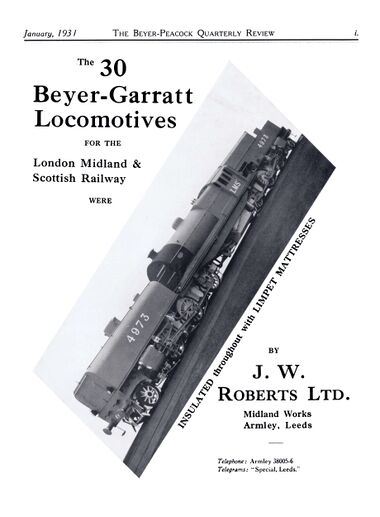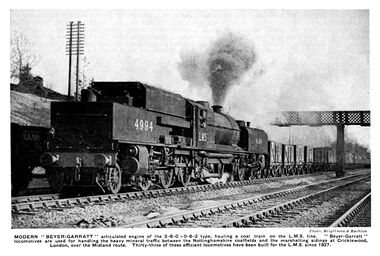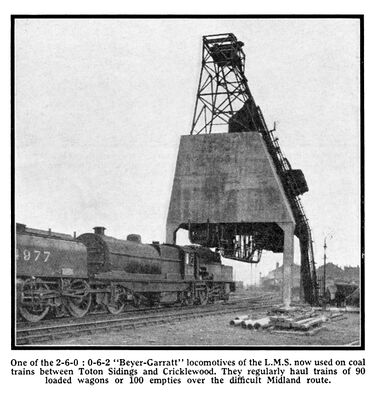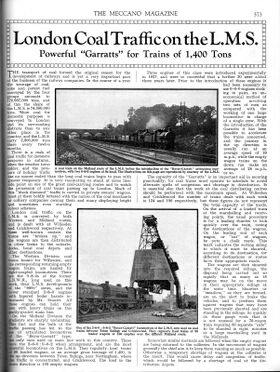Beyer-Garratt locomotive LMS 4999 (thought to be Milbro)
| Exhibit |
|---|
Beyer-Garratt locomotive LMS 4999 (thought to be Milbro) |
 |
| location: |
|
Arch Three , Area 67 1934 |
1931: "Thirty Garratts for the LMS", advert [image info]
Beyer-Garratt locomotive LMS 4994, photo published in 1935 (Railway Wonders of the World) [image info]
LMS Beyer-Garratt loco 4977 recoaling (Meccano Magazine, 1937). Contemporary photographers often found it challenging to get a good picture of the LMS Garratts, due to their awkward length and matt black finish. [image info]
1937: "London Coal Traffic on the LMS: Powerful "Garratts" for loads of 1,400 Tons" [image info]
A black commercially-made working gauge 0 model of LMS Beyer-Garratt (2-6-0) + (0-6-2) articulated locomotive 4999, powered by a pair of Bonds motors (one per drive unit), and made in around 1934. The model is believed to have been produced by Mills Brothers ("Milbro"), but a definitive identification is difficult.
Restoration
The model was acquired in 2016 and sympathetically restored as part of the museum's 2016 anniversary upgrades.
Some indications of the loco's original fittings can be deduced from solder-traces on the loco body and chassis, at positions that correspond to notable details on the original locomotive.
- Oval factory plate added to the front of the boiler (solder trace indicates that this was a planned feature for the model).
- Glazed cab windows
- The loco was missing some of the very distinctive protruding side-pipework of the original. This additional lower side-detailing work (underboiler and pipework) has been painstakingly recreated as a single piece, similar to a dental plate, that fits snugly onto and around the base of the loco with a single screw, and can be removed seamlessly to revert the loco back to its configuration as-found.
- Motors – the two beautiful immaculately-overengineered Bonds motors required no work whatsoever.
Reengineering
The locomotive's linkages between the two drive units and the central boiler and cab were originally fairly crude, and probably not capable of navigating anything less than a four foot six radius curve. Since the linkages are removable, Chris has carefully engineered superior replacements that allow the loco to get around the three-foot-radius curves of the Museum's central layout. The central loco component is now mounted on two floating joints with considerable sideways motion, centred by side springing – this allows both ends of the cab and boiler to shift out to one side of the coupling as required to take a curve, but to re-centre once the loco returns to a straight section of track.
The new side-shifting side-spring linkages work beautifully, and our main issue with the loco is now that ... given the massive hauling power, how we attach enough heavy goods wagons to show off what it's capable of!
The LMS Beyer-Garratts
The powerful LMS "Garratts" were one of the most distinctive types of steam engine to appear on Britain's railways, with 33 of the locos being produced by Beyer Peacock and Company Ltd. from 1927 onwards. Designed for heavy-duty goods work that would otherwise have needed a pair of locomotives, the Garratts were somewhat neglected by toy-and model-makers, partly because of the extra cost and complexity of building a Garratt model (which might have around twice as many parts as a 0-6-0 tank engine, and would presumably need to be priced accordingly), and partly because the Garratts probably didn't catch the 1930s public's attention and imagination in the same way as the glamorous high-profile high-speed passenger locomotives so beloved by model companies.
Painted in dull black, the LMS Garratts often used main lines at night, and since they weren't pulling into passenger mainline terminus stations, many of the public would never have seen them (although they'd have been visible during the day passing through the Midlands). As a result many people with only a passing interest in steam locomotive history associate the exotic Garratt configuration with South African railways, and don't realise that these monsters were also prowling parts of the British railway network.
1937 description (Meccano Magazine, p.573):
London Coal Traffic on the L.M.S.
Powerful "Garratts" for trains of 1,400 Tons
London coal traffic on the L.M.S. is conveyed by both Western and Midland routes, and is dealt with at Willesden and Cricklewood respectively. ...
On the Midland Division the gradients are sharply undulating. This fact and the bulk of the traffic passing has led to the use of articulated locomotives of the "Beyer-Garratt" type, the only ones used on main line work in this country. These have the 2-6-0 : 0-6-2 wheel arrangement, and are the most powerful locomotives on the L.M.S. They regularly haul trains of 90 loaded wagons, or an average gross tonnage of 1,400, in the up direction between Toton Sidings, near Nottingham, where the traffic is concentrated, and Cricklewood. The load in the down direction is 100 empty wagons.
Three engines of this class were introduced experimentally in 1927, and were so successful that a further 30 were added three years later. Prior to the introduction of these engines it had been necessary to use 0-6-0 engines working in pairs, an uneconomical method of operation involving two sets of men as compared with the working of one large locomotive in charge of a single crew. With the introduction of the Garratts it has been possible to accelerate the trains concerned, and the journey in the up direction is usually run at an average speed of 19 m.p.h., while the empty wagon trains on the down run make an average of 24 m.p.h. or so.
The capacity of the "Garratts" is an important aid in securing punctuality, for coal trains must operate to schedule to avoid alternate spells of congestion and shortage in distribution.
— , -, , Meccano Magazine, , October 1937








